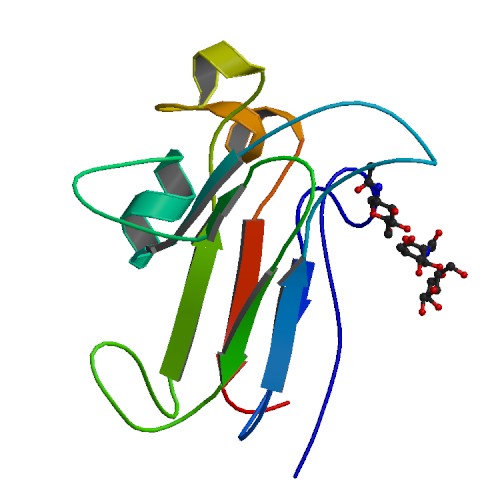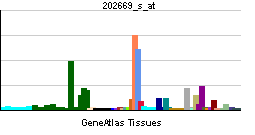EFNB2
| Ephrin-B2 | |||||||||||||
|---|---|---|---|---|---|---|---|---|---|---|---|---|---|
 PDB rendering based on 1iko. | |||||||||||||
| |||||||||||||
| Identifiers | |||||||||||||
| Symbols | EFNB2 ; EPLG5; HTKL; Htk-L; LERK5; MGC126226; MGC126227; MGC126228 | ||||||||||||
| External IDs | Template:OMIM5 Template:MGI HomoloGene: 3019 | ||||||||||||
| |||||||||||||
| RNA expression pattern | |||||||||||||
 | |||||||||||||
 | |||||||||||||
| More reference expression data | |||||||||||||
| Orthologs | |||||||||||||
| Template:GNF Ortholog box | |||||||||||||
| Species | Human | Mouse | |||||||||||
| Entrez | n/a | n/a | |||||||||||
| Ensembl | n/a | n/a | |||||||||||
| UniProt | n/a | n/a | |||||||||||
| RefSeq (mRNA) | n/a | n/a | |||||||||||
| RefSeq (protein) | n/a | n/a | |||||||||||
| Location (UCSC) | n/a | n/a | |||||||||||
| PubMed search | n/a | n/a | |||||||||||
Ephrin-B2, also known as EFNB2, is a human gene.
This gene encodes a member of the ephrin (EPH) family. The ephrins and EPH-related receptors comprise the largest subfamily of receptor protein-tyrosine kinases and have been implicated in mediating developmental events, especially in the nervous system and in erythropoiesis. Based on their structures and sequence relationships, ephrins are divided into the ephrin-A (EFNA) class, which are anchored to the membrane by a glycosylphosphatidylinositol linkage, and the ephrin-B (EFNB) class, which are transmembrane proteins. This gene encodes an EFNB class ephrin which binds to the EPHB4 and EPHA3 receptors.[1]
References
Further reading
- Flanagan JG, Vanderhaeghen P (1998). "The ephrins and Eph receptors in neural development". Annu. Rev. Neurosci. 21: 309–45. doi:10.1146/annurev.neuro.21.1.309. PMID 9530499.
- Zhou R (1998). "The Eph family receptors and ligands". Pharmacol. Ther. 77 (3): 151–81. PMID 9576626.
- Holder N, Klein R (1999). "Eph receptors and ephrins: effectors of morphogenesis". Development. 126 (10): 2033–44. PMID 10207129.
- Wilkinson DG (2000). "Eph receptors and ephrins: regulators of guidance and assembly". Int. Rev. Cytol. 196: 177–244. PMID 10730216.
- Xu Q, Mellitzer G, Wilkinson DG (2001). "Roles of Eph receptors and ephrins in segmental patterning". Philos. Trans. R. Soc. Lond., B, Biol. Sci. 355 (1399): 993–1002. doi:10.1098/rstb.2000.0635. PMID 11128993.
- Wilkinson DG (2001). "Multiple roles of EPH receptors and ephrins in neural development". Nat. Rev. Neurosci. 2 (3): 155–64. PMID 11256076.
- Bennett BD, Zeigler FC, Gu Q; et al. (1995). "Molecular cloning of a ligand for the EPH-related receptor protein-tyrosine kinase Htk". Proc. Natl. Acad. Sci. U.S.A. 92 (6): 1866–70. PMID 7534404.
- Bonaldo MF, Yu MT, Jelenc P; et al. (1995). "Selection of cDNAs using chromosome-specific genomic clones: application to human chromosome 13". Hum. Mol. Genet. 3 (9): 1663–73. PMID 7833926.
- Cerretti DP, Vanden Bos T, Nelson N; et al. (1996). "Isolation of LERK-5: a ligand of the eph-related receptor tyrosine kinases". Mol. Immunol. 32 (16): 1197–205. PMID 8559144.
- Cerretti DP, Lyman SD, Kozlosky CJ; et al. (1997). "The genes encoding the eph-related receptor tyrosine kinase ligands LERK-1 (EPLG1, Epl1), LERK-3 (EPLG3, Epl3), and LERK-4 (EPLG4, Epl4) are clustered on human chromosome 1 and mouse chromosome 3". Genomics. 33 (2): 277–82. doi:10.1006/geno.1996.0192. PMID 8660976.
- Gale NW, Holland SJ, Valenzuela DM; et al. (1996). "Eph receptors and ligands comprise two major specificity subclasses and are reciprocally compartmentalized during embryogenesis". Neuron. 17 (1): 9–19. PMID 8755474.
- Holland SJ, Gale NW, Mbamalu G; et al. (1996). "Bidirectional signalling through the EPH-family receptor Nuk and its transmembrane ligands". Nature. 383 (6602): 722–5. doi:10.1038/383722a0. PMID 8878483.
- "Unified nomenclature for Eph family receptors and their ligands, the ephrins. Eph Nomenclature Committee". Cell. 90 (3): 403–4. 1997. PMID 9267020.
- Vogt T, Stolz W, Welsh J; et al. (1998). "Overexpression of Lerk-5/Eplg5 messenger RNA: a novel marker for increased tumorigenicity and metastatic potential in human malignant melanomas". Clin. Cancer Res. 4 (3): 791–7. PMID 9533549.
- Wang HU, Chen ZF, Anderson DJ (1998). "Molecular distinction and angiogenic interaction between embryonic arteries and veins revealed by ephrin-B2 and its receptor Eph-B4". Cell. 93 (5): 741–53. PMID 9630219.
- Nikolova Z, Djonov V, Zuercher G; et al. (1998). "Cell-type specific and estrogen dependent expression of the receptor tyrosine kinase EphB4 and its ligand ephrin-B2 during mammary gland morphogenesis". J. Cell. Sci. 111 ( Pt 18): 2741–51. PMID 9718367.
- Torres R, Firestein BL, Dong H; et al. (1999). "PDZ proteins bind, cluster, and synaptically colocalize with Eph receptors and their ephrin ligands". Neuron. 21 (6): 1453–63. PMID 9883737.
- Lin D, Gish GD, Songyang Z, Pawson T (1999). "The carboxyl terminus of B class ephrins constitutes a PDZ domain binding motif". J. Biol. Chem. 274 (6): 3726–33. PMID 9920925.
| This protein-related article is a stub. You can help Wikipedia by expanding it. |